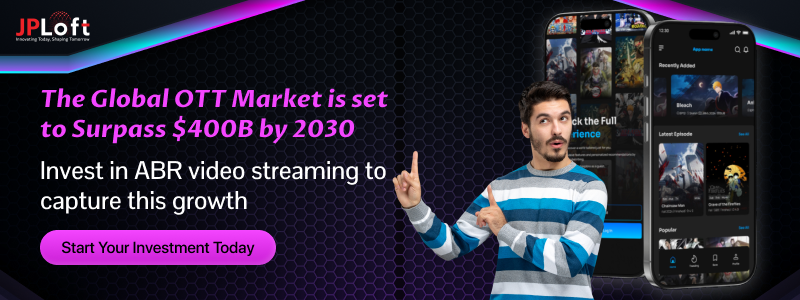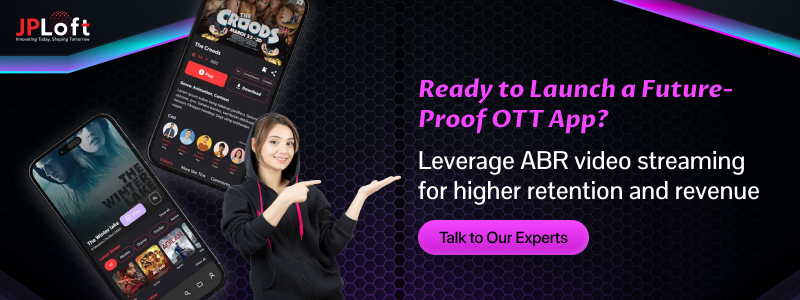Key Takeaways
ABR video streaming ensures smooth playback by adjusting quality in real time, solving buffering issues, and keeping users engaged longer.
The role of ABR video streaming in OTT apps is to deliver uninterrupted, adaptive viewing that boosts user satisfaction, strengthens retention, and fuels business growth.
OTT platforms with ABR reach wider audiences, from high-speed urban networks to mobile-first rural regions, expanding global market presence.
By reducing churn and boosting watch time, ABR directly drives ad revenue, premium subscriptions, and long-term monetization opportunities.
Future ABR innovations with AI and ultra-low latency streaming will make OTT apps more personalized, scalable, and sustainable.
JPLoft helps businesses integrate ABR into OTT platforms with the right tech stack, ensuring scalability, monetization, and a future-proof streaming experience.
“Intelligence is the ability to adapt to change.” — Stephen Hawking.
This quote perfectly captures the foundation of ABR (Adaptive Bitrate) video streaming in today’s OTT landscape. Viewers demand uninterrupted, high-quality content, yet their network conditions constantly shift.
This brings us to the key question, “What is the role of ABR video streaming in powering the future of digital entertainment?”
ABR video streaming adapts video quality in real time, reducing buffering and ensuring smooth playback. It enhances user satisfaction, boosts retention, and drives growth in modern streaming platforms.
For entrepreneurs, this means building OTT platforms that deliver superior viewing experiences and higher engagement. For investors, it highlights a profitable backbone technology that drives user retention, opens monetization pathways, and strengthens long-term ROI.
This blog will break down why ABR isn’t just a technical feature but a strategic driver of growth in the streaming industry.
Let’s evaluate every key aspect of ABR video streaming in OTT apps together.
What is ABR Video Streaming?
Adaptive Bitrate (ABR) streaming of videos is a key streaming technology that provides smooth content delivery over fluctuating internet conditions. Rather than transmitting a single fixed-quality version of a video, ABR builds multiple renditions at varying resolutions like 240p, 480p, 720p, and 1080p.
While the content is in progress, the system continuously monitors accessible bandwidth and device capability. From this analysis, it seamlessly switches versions, producing higher quality when there is a strong connection and reducing immediately if the network speed falls.
This flexibility equates to playback uninterrupted by buffering, which translates straight into more engaged and happier viewers. For investors, the importance is in scalability and retention: ABR enables platforms to stream audiences across regions with non-uniform internet infrastructures, from high-speed fiber economies to mobile-first economies.
By reducing churn due to suboptimal playback, it reinforces monetization models such as subscriptions, advertising, and pay-per-view.
The business model is simple: ABR grows user watch time, minimizes abandonment, and enables premium offerings like 4K and live events without estranging users on lower-speed connections.
In a crowded OTT marketplace, this technology is not about streaming quality; it's a platform growth driver, investor confidence creator, and long-term revenue opportunity enabler.
Let’s look forward to the market analysis of ABR technology in the following section.
Market Landscape & Growth Potential of the ABR Approach
Learning about the video streaming market statistics can help identify the core insights about the industry. It provides you with a broad perspective to decide whether it's a useful technology to invest in or not.
Let’s look at the given stats.
-
The global video streaming market size is expected to reach USD 416.8 billion in 2030. That is further projected to grow at a CAGR of 21.5% from 2025 to 2030.
-
Additionally, this market size is estimated to grow by USD 20.64 billion from 2025 to 2029, at a CAGR of 16.6%.
-
Additionally, with the use of the ABR algorithm, a traffic reduction of 60.87% has been observed without impairing user experience.
-
Over 72% of the live streaming platforms do support ABR, from 50% in 2022.
Deploying ABR in video streaming platforms does help in offering video streaming dominance and enhances the user experience.
Well, are you ready to invest in ABR technology? If not yet, let’s move ahead to the importance of implementing ABR in OTT apps.
Why ABR is a Critical Investment Driver in OTT Apps?
When you start an online video streaming business, it becomes important to add recent trends and technology to sustain in this competitive landscape. Thus, ABR comes into the picture.
But, now the question is “why is ABR an important investment for OTT apps?” Let’s check them out below.
1. Guaranteed Playback Quality Across Networks
Adaptive Bitrate streaming adjusts video quality in real time, ensuring uninterrupted viewing even on unstable networks. This reliability keeps audiences engaged and reduces churn, making OTT platforms more attractive to investors focused on retention metrics.
2. Wider Audience Reach in Diverse Markets
ABR video streaming apps allow a single platform to serve both high-speed broadband users and mobile-first consumers with weaker connections. By covering all bandwidth tiers, OTT platforms expand their user base globally, strengthening revenue potential and investor confidence.
3. Higher Viewer Retention and Monetization
ABR in video streaming apps do offer seamless playback directly impacts how long users stay on the platform. With ABR minimizing buffering, watch time increases, creating more opportunities for ads, upselling, and premium subscriptions, translating into stronger ROI for stakeholders.
4. Scalability for Live and On-Demand Streaming
From blockbuster premieres to live sports events, ABR can handle sudden spikes in demand without breaking user experience. This scalability makes OTT businesses more resilient and appealing to investors who value predictable performance under heavy load.
5. Cost-Efficient Delivery With CMAF and Cloud
ABR, when combined with standards like CMAF, reduces storage and delivery costs by unifying video formats. For investors, this efficiency means lower operating expenses and higher margins while still delivering premium viewing experiences.
6. Enabler of Advanced Features (4K, HDR, AV1)
Premium video formats such as 4K UHD, HDR, or AV1 compression are only viable when delivered adaptively. ABR ensures these high-quality streams don’t alienate users on weaker connections, making it a future-proof investment driver for OTT growth.
Other than the above-mentioned importance of using ABR in video streaming apps, this method is effective in enhancing user experience, providing support for low-latency, and even helpful in improving accessibility across devices.
Investors should look at the maximum aspect when it comes to implementing ABR technology in video streaming apps.
You can build a video streaming app by integrating ABR technology after learning about its complete role. Let’s check out the role of ABR video streaming below.
Role of ABR Video Streaming Explained
If you are the one who wants to convert a video streaming app idea into reality, then adopting the recent trends and apps with updated technology can be helpful.
Pursuing the recent trends, Adaptive Bitrate (ABR) video streaming has become a cornerstone of modern OTT platforms, ensuring that content is accessible, smooth, and engaging across different devices and network conditions.
Its role goes beyond just reducing buffering; ABR directly impacts user satisfaction, platform scalability, and long-term revenue growth.
Let’s check out the role of ABR video streaming below.
► Driving Seamless Experiences Across Devices
ABR in video streaming apps ensures that video playback adjusts automatically, whether viewers are on a smart TV, tablet, or mobile phone. This flexibility guarantees consistent quality, making OTT apps accessible and reliable for a wide range of users.
► Boosting Global Market Expansion
By catering to audiences with varying internet speeds, from 5G connections to slower rural networks, ABR video streaming apps allow platforms to penetrate untapped regions. This inclusivity expands the global user base and strengthens overall market presence.
► Enabling Revenue Optimization
Higher engagement through smooth streaming increases ad impressions, subscription renewals, and pay-per-view purchases. ABR video streaming apps indirectly fuel monetization by maximizing watch time and minimizing churn rates.
► Supporting Live Event Reliability
For live sports, concerts, and global premieres, ABR helps manage sudden spikes in traffic. This stability builds trust with users and advertisers, ensuring OTT platforms can deliver premium live experiences without compromise.
► Optimizing Operational Costs
Through intelligent bitrate adjustments and compatibility with formats like CMAF, ABR reduces storage duplication and delivery overheads. This efficiency means OTT businesses save costs while maintaining high service standards.
► Preparing for Next-Gen Streaming Formats
ABR video streaming is critical for rolling out advanced features such as 4K UHD, HDR, and AV1 compression. It future-proofs OTT platforms, allowing them to meet growing consumer expectations for ultra-high-definition content.
Apart from the above-defined roles of ABR video streaming, this approach helps to gain the trust of the target audiences by providing them with the content quality as per their preferences and the availability of network connections.
Key Technologies Behind ABR Video Streaming
The key technologies behind ABR video streaming rely on different technologies that work together to deliver the best possible viewing experience for a user’s current network conditions.
You should select the video streaming app tech stack based on different factors such as the type of app, audience size, long-term business goals, and current trends in technology.
One of these technologies is ABR video streaming, and to adopt it in the app, you will be required to have an effective set of backend and front-end tech elements. Let’s discuss the technologies behind ABR video streaming below.
1] HTTP Adaptive Streaming Protocols (HLS, DASH, MSS, CMAF)
Protocols like HLS (Apple), MPEG-DASH, and Microsoft Smooth Streaming (MSS) are the backbone of ABR.
They break the video into small segments at multiple quality levels and let the player request the best segment based on network conditions. CMAF (Common Media Application Format) further unifies HLS and DASH to cut storage and delivery costs.
2] Video Codecs (H.264, H.265/HEVC, AV1, VP9)
Codecs compress the video into smaller sizes without losing perceptible quality.
Of the three, H.264 is the most used, followed by H.265/HEVC and AV1, which provide better compression efficiency, something that is critical for high-quality streaming at lower bitrates. This efficiency makes ABR work well across a variety of networks.
3] Media Players (HTML5, ExoPlayer, AVPlayer, Shaka Player)
ABR demands smart players that can read manifest files, monitor bandwidth, and change streams in real time.
The most commonly used adaptive playback players are HTML5 Video, Shaka Player (Google), ExoPlayer (Android), and AVPlayer (iOS) - used by most of the big OTT platforms.
4] Content Delivery Networks (CDNs)
CDNs cache and deliver content closer to users worldwide. In ABR, CDNs ensure segment availability at scale, minimize latency, and help manage sudden spikes in traffic during live streaming events.
Without CDNs, ABR would struggle to scale globally. This will be an important technology that supports the integration of ABR in video streaming apps.
5] Media Segmenters and Packagers
Before streaming, video content must be broken into small segments and packaged into formats compatible with HLS/DASH.
Tools such as FFmpeg, AWS Elemental MediaPackage, and Wowza provide this with a component of adaptive delivery.
6] QoE/QoS Monitoring Tools
QoE and QoS monitoring tools continuously track playback performance, buffering, and bitrate switching.
Platforms such as Conviva or NPAW provide analytics that help optimize ABR algorithms and maintain viewer satisfaction.
7] DRM and Security Frameworks
To protect premium content, ABR integrates with DRM solutions like Widevine, PlayReady, and FairPlay. These systems ensure adaptive streams remain secure while scaling across devices and networks.
Let’s summarize the technologies used for ABR video streaming in the given table.
|
Technology Category |
Examples/Standards |
Role in ABR Video Streaming |
|
Streaming Protocols |
HLS, MPEG-DASH, MSS, CMAF |
Segment video at multiple bitrates and enable adaptive delivery. |
|
Video Codecs |
H.264, H.265/HEVC, AV1, VP9 |
Compress video efficiently for smooth playback at lower bitrates. |
|
Media Players |
HTML5 Player, Shaka, ExoPlayer, AVPlayer |
Detect network changes and switch bitrates in real time. |
|
Content Delivery Networks |
Akamai, Cloudflare, AWS CloudFront |
Deliver segmented video globally with low latency and high availability. |
|
Packagers & Segmenters |
FFmpeg, AWS Elemental, Wowza |
Convert and package video into adaptive segments for protocols. |
|
Monitoring & Analytics |
Conviva, NPAW, Bitmovin Analytics |
Track QoE, buffering, and bitrate switching to improve ABR logic. |
|
DRM & Security |
Widevine, PlayReady, FairPlay |
Secure adaptive streams against piracy and unauthorized use. |
After looking forward to the key technologies used in modern OTT apps, let’s get ahead with different monetization and ROI frameworks.
Monetization & ROI from ABR Video Streaming
How do video streaming apps make money? Well, there are many monetization frameworks used here, such as subscription plans, advertisements, in-app purchases, and many more
You can make money from implementing ABR video streaming by following the right strategies. Let’s evaluate all the monetization frameworks below.
A] Higher Watch Time = Higher Ad Revenue
As ABR video streaming cuts down on buffering and increases playback quality, users watch for longer. This translates to a direct increase in ad impressions for AVOD models and optimizes CPM-based returns, making ad-driven revenue streams more robust.
B] Premium Subscription Tiers
By supporting high-quality resolutions such as 4K, HDR, and AV1 without excluding low-bandwidth customers, ABR allows for differentiated subscription plans to be launched by platforms. Paying customers who are willing to pay for higher quality have higher ARPU, which is the primary ABR video streaming monetization tactic.
C] Increased Retention Lowers Churn Costs
Seamless playback alleviates frustration and abandonment. Keeping existing subscribers costs much less than bringing in new ones, so ABR generates ROI by reducing churn-related costs while increasing customer lifetime value.
D] Scalable Global Expansion
ABR video streaming provides consistent performance for fluctuating network environments, from mature broadband markets to developing mobile-first economies. This interoperability enables platforms to enter new markets more quickly, tapping into diversified revenue streams at scale.
E] Operational Cost Savings through Efficient Delivery
By employing standards such as CMAF, ABR minimizes redundant storage and maximizes CDN bandwidth. Lower delivery expenses translate into greater profit margins per stream, immediately enhancing ROI without impacting service quality.
F] Support for Hybrid Monetization Models
ABR simplifies the execution of hybrid models such as SVOD + AVOD or event-based pay-per-view. With consistent quality across audiences, OTT platforms can confidently monetize live events, exclusive shows, and ad-supported plans under a single ecosystem.
After evaluating the monetization frameworks, let's begin with the risks and challenges in the given section.
ABR Video Streaming: Risks & Challenges for Investors
The video streaming app development challenges do include poor market study, lack of effective design, etc., while when it comes to ABR video streaming, let’s check for the complete list of risks and challenges it includes.
Although ABR video streaming is undeniable in its growth potential, it also has challenges that have to be considered by investors. Such risks affect costs, scalability, and long-term ROI if not properly managed. Here’s the list to learn.
1. High Infrastructure and Encoding Costs
ABR video streaming demands producing numerous versions of the same content at different bitrates and resolutions. This multiplies encoding, storage, and CDN delivery costs, which can consume margin if a platform is not in scale.
2. Complexity of Implementation and Management
Implementing ABR in video streaming apps is not plug-and-play. It requires smart players, packaging, monitoring software, and optimized CDN access. The technical complexity can extend development times and operational costs for OTT startups.
3. Latency in Live Streaming
Even though ABR video streaming ensures playback stability, it causes latency in live events because of segment encoding and buffering. In the case of sports or interactive streams, a delay of a few seconds would affect user confidence and advertiser trust.
4. Bandwidth and CDN Dependency
ABR video streaming relies heavily on CDN quality and bandwidth available in various markets. Scarce or costly bandwidth within developing economies can degrade stream quality, hindering user expansion even with adaptive delivery.
5. Security and Piracy Issues
Additional renditions and distributed delivery create additional surfaces for piracy or unauthorized downloads. Without secure DRM integration, platforms risk content leaks that can translate to revenue loss and brand damage.
6. User Experience Consistency Across Devices
Not all players or devices support ABR as well. On unsupported browsers or older devices, adaptive switching can also fail, and this can result in inconsistent experiences that damage retention.
After evaluating these video streaming risks and challenges, you can proceed to integrate ABR in video streaming platforms.
Yes, when you implement certain technology in your app, one of the issues that might bother you is whether it has a future or it's just a current part of usage. Well, to address this concern related to ABR video streaming, let’s proceed with the given section.
Future of ABR: Outcomes Expected Further
When it comes to adopting ABR, identifying its video streaming app trends is crucial.
The ABR's role in video streaming is only going to increase as consumer demand and technology improve. These are the key outcomes anticipated in the next few years:
► AI-Driven Adaptive Algorithms
Next-generation ABR video streaming will apply artificial intelligence and machine learning, highlighting the growing role of AI in video streaming apps. Instead of only reacting in real time, systems will forecast user behavior and network variability, actively adapting quality for even more seamless experiences.
► Wider Adoption of Next-Gen Codecs
As codecs such as AV1, VVC, and EVC become more mainstream, ABR for video streaming will provide more video quality at lower bitrates. This decreases bandwidth expenses for providers while enhancing accessibility to users on slower connections.
► Ultra-Low Latency Streaming
The push for live sport, esports, and interactive streaming will drive ABR technology in the direction of ultra-low latency solutions. Advances in segment duration and edge processing will reduce delay to almost real-time.
► Personalized Streaming Experiences
ABR video streaming will integrate with personalization engines, customizing not only quality but also advertisements, suggestions, and playback choices. Personalization fuels more engagement and monetization potential.
► Richer Integration with Cloud and Edge Computing
Cloud-native processes and edge caching will enable ABR in video streaming to scale in seconds and provide localized content cost-effectively. This minimizes buffering for worldwide audiences and optimizes platform scalability.
► Support for Immersive Media (VR/AR/360°)
As immersive formats go mainstream, ABR will evolve to stream VR, AR, and 360° video seamlessly across devices. Its performance-bandwidth balance guarantee makes such bandwidth-intensive formats commercially feasible.
► Improved Monetization Models
With reliable playback, platforms can safely introduce hybrid models such as SVOD + AVOD or pay tiers for UHD. ABR technology supports these ABR video streaming monetization models through guarantees of quality consistency among disparate audiences.
► Increased Emphasis on Sustainability
Next-generation ABR deployments will optimize encoding ladders to minimize energy usage and bandwidth consumption. This green initiative is in line with worldwide sustainability objectives while keeping providers' costs down.
If you are still concerned, connecting with the leading mobile app development company can be helpful.
Case Studies: OTT Success Stories with ABR
When you invest in a technology, it becomes important to look for the top video streaming apps as a case study. It will provide you with the complete idea of what these apps are doing to integrate ABR and how it is helping them to engage potential users.
1. YouTube
YouTube has also been a leader in ABR video streaming, employing MPEG-DASH and VP9/AV1 codecs to dynamically adapt quality in billions of streams per day.
Its player adapts resolutions automatically, ranging from 144p to 8K, based on real-time bandwidth. This adaptability makes YouTube workable in low-penetration internet areas while retaining the capability for high-end UHD experiences.
While considering the cost to create an app like YouTube, including the ABR approach will improve your app’s performance.
2. Netflix
Netflix uses ABR in video streaming using both HLS and DASH protocols, with sophisticated per-title encoding. Rather than static renditions,
Netflix adapts bitrate ladders to every show or film, optimizing quality while minimizing bandwidth expense. This practice optimizes user experience all over the world and has been key to its subscriber retention strategy.
When it comes to analyzing the cost to build an app like Netflix considering the ABR video streaming method as an additional technology will improve your app’s sustainability in the market.
3. Hulu (Disney Streaming)
Hulu employs ABR through HLS and CMAF packaging to provide seamless playback on mobile, web, and connected TV from the start.
By preserving adaptive playback throughout ad-supported and subscription viewing, Hulu delivers maximum ad impressions and elevated engagement metrics, rendering ABR a direct monetization driver.
If you are wondering about building an app like Hulu, including the feature of ABR can help you to connect with the target users successfully, and is even helpful to deliver high-quality content based on the user’s needs.
4. Stan (Australia)
Stan uses ABR to deliver Australia's multi-faceted broadband environment, ranging from high-speed fiber in urban areas to mobile in the bush.
With ABR combined with MPEG-DASH and HLS, Stan delivers seamless viewing quality and UHD support for high-end subscribers, enabling it to expand as a top-tier regional OTT operator.
The overall cost to build an app like Stan does depend on different kinds of features, including basic and normal. One of the prospects to consider here is ABR video streaming technology.
5. Twitch
Being a live streaming giant, Twitch relies on ABR video streaming to transcode the live streams to various quality levels in real time.
Auto-adjust and manual selection of quality based on the network are available for viewers. ABR allows Twitch to have low-latency interactivity for millions of users simultaneously worldwide.
If you are wondering how to build an app like Twitch, you should know how the app earns money, gains the audience’s trust, and leads the competitive market. ABR approach is one of the core tech that this app adopts to improve the user experience.
6. Peacock TV
Peacock, NBCUniversal's OTT streaming service, employs ABR with CMAF, DASH, and HLS to handle its hybrid model of free ad-supported and premium subscription options.
The adaptive strategy guarantees live sports, movies, and TV shows are streamed at consistent quality on mobile and connected devices.
The cost to develop an app like Peacock TV ranges from $20,000 to $50,000+.These costs do include the different types of technologies that the app includes to reach out to the users.
7. Paramount+
Paramount+ integrates ABR streaming with both DASH and HLS to deliver content in multiple renditions.
Its focus on live events, sports, and global expansion makes ABR vital for reducing buffering in bandwidth-limited markets, while also supporting HDR and UHD content for premium subscribers.
For investors exploring how to develop an app like Paramount, ABR is a proven foundation that enables scalability, monetization, and a superior viewing experience.
8. HBO Max (now rebranded as Max in some regions)
HBO Max employs ABR both for VOD and live content to deliver its premium 4K HDR library in seamless playback.
With per-title optimization and CMAF packaging, ABR supports cost-effective delivery of big-ticket movies and episodic content while keeping profitability through bandwidth efficiency.
Additionally, for businesses exploring how to develop an app like HBO Max, ABR serves as a core technology to balance performance, scalability, and viewer satisfaction.
After learning about the case studies, let’s proceed with how you can invest in this technology or enter the ABR video streaming market in the section below.
Investor Guide: How to Enter the ABR Video Streaming Market?
Do you know why video streaming apps fail? One of the major reasons is that you don’t know how to begin. The right strategy and guidance play a key role.
If you have decided to enter the ABR video streaming market, then following the given steps can help. Let’s learn them all here.
Step 1: Begin with Market Fit and Use Cases
Select lanes that have actual monetization: live sports, high-quality VOD, FAST/AVOD, education, or enterprise video.
Chart the application of ABR in video streaming apps to each lane, how reduced rebuffering and broader device reach map onto ARPU, ad fill, and reduced churn.
Step 2: Select Standards that Scale (HLS/DASH + CMAF)
Scale on well-supported rails: HLS and MPEG-DASH, delivered through CMAF to reduce storage/egress.
This mitigates the risks of device coverage, speeds up integrations with ABR video streaming platforms, and leaves future codecs such as AV1/VVC open as an option.
Step 3: Design the Encoding Ladder with a Purpose
Per-title and content-aware ladders are more important than bitrate counts in the raw.
Optimize for QoE, not ego 4K itself: segment length, keyframe placement, and audio ABR. Cleaner ladders save CDN expense and raise session duration, clean ROI drivers.
Step 4: Choose a Player Stack That's Analytics-First
Shaka/ExoPlayer/AVPlayer with strong ABR logic, MSE/EME, DRM, and QoE beacons (startup time, stall ratio, bitrate switches).
Make telemetry a profit center: it drives A/B tests, ad-tier tuning, and pricing experiments on ABR in video streaming platforms.
Step 5: Construct a Hybrid Monetization Model From Day One
Combine SVOD, AVOD/FAST, TVOD, and event PPV. ABR in video streaming allows steady quality at all levels, so upsells (4K, HDR, downloads) become deserving of a price to pay.
Attach quality promises to pricing pages to validate premium tiers.
Step 6: Leverage the Edge to Dominate Live and New Markets
Deploy origin offload, edge packaging, and just-in-time encryption. Reduced segments for low-latency events; intelligent CDN routing for mobile-first territories.
This is the way ABR in video streaming platforms translates to actual reach, improved ad viewability, and repeat viewership.
Step 7: De-Risk with Security and Compliance Upfront
Fix Widevine/PlayReady/FairPlay, watermarking, and license rotation.
Stable DRM combined with ABR secures premium catalogs while enabling device diversity, key for studio deals and sports rights.
Step 8: Create a Cost Model That Thrives at Scale
Model per-hour expenses across encoding, storage, CDN, player licenses, and QoE tooling. When you add ABR, the cost to create a video streaming app will be impacted.
Hence, perform sensitivity tests: ladder size, segment length, codec mix. The objective: a unit-economics perspective displaying ABR's quality improvements along with margin preservation.
Following these steps will help integrate the smart technology as ABR in video streaming and can result in engaging your target users.
Talk to the Experts of JPLoft, and Invest in an ABR Streaming Approach
Investing in ABR streaming is not just a technical choice; it's a strategic one that has a direct effect on growth, user engagement, and long-term profit.
With viewers expecting seamless playback between devices and networks, ABR is the bedrock on which to build high-end viewing experiences without breaking the bank on delivery.
Investors can expect increased engagement, increased ad impressions, and increased subscription renewals.
Partnering with a trusted video streaming app development company like JPLoft ensures that your investment aligns with the right technology stack, global standards, and monetization models.
From per-title optimization to hybrid revenue strategies, JPLoft helps design streaming platforms that balance quality and scalability.
By embedding ABR into the core of your business model, you’re not just supporting smooth playback; you’re building an OTT ecosystem positioned for expansion in fast-growing markets. Speak with the experts today and gain a competitive advantage in the streaming economy.
Conclusion
Adaptive Bitrate (ABR) video streaming has proven to be the backbone of modern OTT success.
By ensuring seamless playback, reducing churn, and enabling global scalability, ABR not only enhances user experience but also strengthens monetization models for investors.
With the market projected to surpass $400 billion by 2030, adopting ABR in video streaming apps is no longer optional-it’s a growth imperative.
Platforms like Netflix, YouTube, and HBO Max demonstrate how ABR drives engagement and profitability at scale. For investors and stakeholders, the future of ABR is about more than technology, it’s about unlocking consistent ROI and market expansion.
FAQs
ABR video streaming dynamically adjusts video quality to network conditions, ensuring smooth playback and a consistent user experience. It works by creating multiple renditions of the same content at different resolutions. The player then selects the best version in real time, keeping the viewing experience uninterrupted.
It boosts watch time, reduces churn, and enables monetization through ads, subscriptions, and premium content delivery worldwide. By maintaining playback quality even on unstable networks, ABR ensures that platforms appeal to broader audiences. This reliability directly contributes to higher retention and improved revenue streams.
Netflix, YouTube, Hulu, Twitch, Peacock TV, and HBO Max all rely on ABR to deliver adaptive, high-quality streaming. These platforms leverage ABR to handle massive traffic spikes while offering consistent experiences. It has become the gold standard for OTT services worldwide.
ABR ensures scalability, efficient delivery, and higher user retention, making it a critical driver of long-term ROI. It reduces the risk of churn by guaranteeing user satisfaction across varying markets. For investors, this means more predictable growth and sustainable monetization models.
Yes, ABR with CMAF lowers storage duplication and CDN costs, leading to higher margins for OTT providers. Optimizing video delivery reduces unnecessary bandwidth consumption. This efficiency helps platforms maximize profits while still offering premium-quality streaming.
Future ABR will use AI-driven prediction, ultra-low latency streaming, next-gen codecs, and edge computing for scalable growth. These innovations will make video delivery more personalized and sustainable. As OTT markets expand, ABR will remain a foundation for competitive advantage.













Share this blog